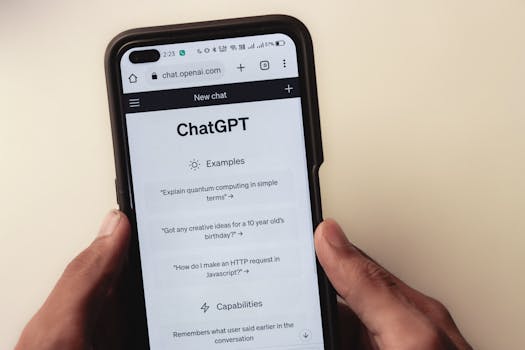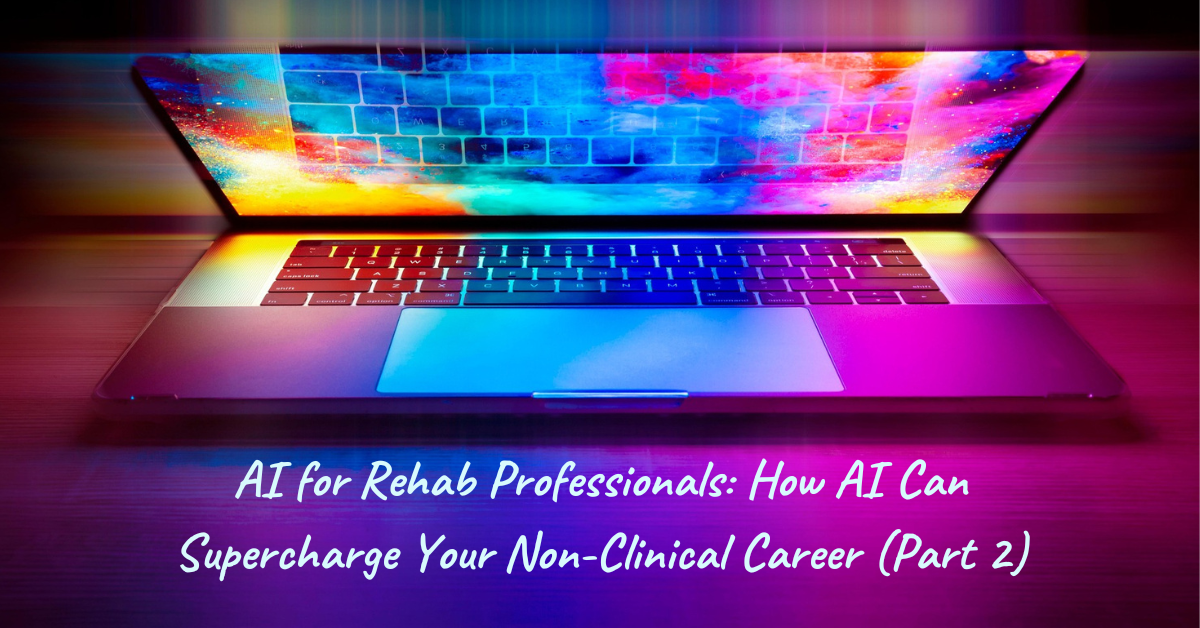This series is specifically designed to answer your questions and explain how AI is more friend than foe in your career. Missed Part 1 of the series? Read it here: AI for Rehab Professionals: Getting Started (Part 1)
In Part 2, we’ll demonstrate how AI can be a powerful tool to enhance your existing (and future) skills. We will also walk you through practical applications, explore new career opportunities it unlocks, and empower you to future-proof your career in the rapidly changing healthcare landscape.
We will keep it simple and focus on what you need. We’ve also addressed some of the most common questions and concerns about AI in this article, but if you have any more questions, we’d love to hear from you in the comments!
This post may contain affiliate links or codes. This won’t increase your cost, but it helps keep TNCPT alive, and free of annoying ads! Thank you for your support. 🙂
Addressing the Elephant in the Room (aka Your Questions & Concerns)
Diving into AI can feel a bit like stepping into the unknown. It’s natural to have questions, and maybe even a few worries! After all, as rehab professionals, we’re wired to be thoughtful and responsible. So, let’s tackle some of those common questions and concerns head-on, because knowledge is power, right? 💪

Your Burning Questions, Answered
Q: Will AI take my job? (Seriously, should I be worried?)
A: We get it. New technology can be scary because it inevitably brings about change. But think of it this way: Excel didn’t replace accountants, and AI won’t replace rehab professionals. Instead, AI is a tool that can make your life easier—and make you more valuable in the job market. In fact, AI is already expanding non-clinical opportunities for rehab pros! The key is to learn how to leverage AI, not fear it. By following the action plan below to familiarize yourself with different AI tools, understand how they’re used in your industry, and master the art of prompting, you’re already on the right track!
Q: Can AI help me with the dreaded resume and job search?
A: Yes…and no. AI can help you write a resume, but we strongly recommend against letting it do the whole job. Recruiters can often spot AI-generated content, and it’s a major turnoff. That said, AI can be a fantastic assistant for identifying your transferable skills, optimizing your resume and LinkedIn profile for applicant tracking systems (ATS), and even practicing your interviewing skills. Just remember to always personalize and proofread anything AI generates—you want to sound like you, not a robot! (Stay tuned for future blog posts on this topic, and Non-Clinical 101 students, check out the AI bonus lesson and ATS-friendly templates!)
Q: Are AI chatbots accurate? Can I really trust them?
A: This is a BIG one, especially for us evidence-based practitioners. The short answer is: AI chatbots are incredibly powerful, but they’re not infallible. They can sometimes “hallucinate”—which is a fancy way of saying they make stuff up. So, always, always use your clinical judgment and double-check information from reliable sources. Think of AI as a helpful assistant, not a replacement for your brain!
Q: What about HIPAA? Is it safe to use AI with patient information?
A: Never, ever enter patient-identifiable information into a general AI chatbot (like ChatGPT or Claude). If you’re using AI for clinical purposes, make absolutely sure the tool is specifically designed for healthcare, complies with HIPAA regulations, and is approved by your workplace. Patient privacy is paramount, and using the wrong AI tool could lead to serious consequences.
Common Clinical Concerns
Privacy & HIPAA Compliance: This is HUGE. Patient privacy is non-negotiable in healthcare. AI’s reliance on massive datasets raises critical data security questions for healthcare professionals. Even with assurances from many AI models that they are not using chat data for training, caution is still key. Therefore, always adhere to this rule: confidential patient information belongs only within officially sanctioned and secure AI tools. Always check with your workplace!
Evidence vs. Misinformation: Rehab pros are evidence-based! So, it’s a valid question: is AI just internet fluff? Sometimes, yes! AI can “hallucinate” (aka make stuff up), so your critical thinking is KEY. Think of AI as a starting point, speeding up research or offering perspectives. You’re the expert, applying your clinical judgment and verifying the information. AI assists, but it does not replace your expertise.
Ethical Considerations: AI is powerful tech, and with great power comes great responsibility, right? Are AI algorithms biased? Potentially, yes—because they learn from data, and data can reflect existing biases in the world. That’s why it’s so important to have diverse voices, including rehab professionals, involved in developing and using AI in healthcare. We can help ensure these tools are used ethically and equitably in our field.
Cost & Access: Will AI be another pricey tool, widening healthcare gaps? It’s important to ensure that AI advancements actually improve healthcare access, not widen existing gaps. Think about telehealth solutions powered by AI, or tools that can automate administrative tasks and free up clinicians’ time. The key is to advocate for thoughtful implementation and policies that ensure AI benefits everyone, not just a select few.
Patient-Provider Relationship: Will AI turn healthcare into a cold, robotic experience? Remember, AI is a tool. It’s meant to enhance what we do, not replace the human connection that is so crucial in rehab. Think about AI assisting with documentation, or analyzing movement patterns to personalize treatment plans—these are things that can actually free up more time and energy for you to focus on what you do best: connecting with your patients, understanding their individual needs, and providing that human touch that no robot can replicate.
AI can be a powerful partner in strengthening the patient-provider relationship, making care more efficient and effective, and ultimately, helping us help our patients even better.
The bottom line: we’re not suggesting you blindly jump into the AI deep end. It’s about being informed and using tools thoughtfully. And reading this? You’re already taking the first step! Now, let’s flip to the amazing opportunities AI brings to rehab pros!
Non-Clinical Opportunities with AI
AI is becoming increasingly integrated into all aspects of business and healthcare. Ignoring it is like ignoring the internet in the early 2000s. (For those of you old enough to remember!)
Here’s where things get really exciting, especially if you’re itching to break free from the clinic. AI isn’t just changing how healthcare is delivered; it’s creating entirely new career paths for savvy rehab professionals like you. And frankly, we’re blown away by the very real, practical ways AI is already transforming rehab therapy.
Think about it: AI-powered tools are personalizing treatment plans, enabling remote monitoring, and even making therapy more engaging through gamification and virtual reality. These advancements aren’t just cool tech—they’re creating a massive need for people who understand both the technology and the clinical side.
This is where you come in. Your clinical expertise is invaluable, particularly when it comes to ensuring that these powerful tools are used safely and ethically.
Non-clinical roles in health tech, consulting, education, and data analysis are increasingly seeking professionals with a rehab background and AI literacy. This is your chance to combine your passion for helping people with cutting-edge technology.
Beyond those established paths, AI can be a game-changer for entrepreneurs. Understanding it can give you a serious competitive edge. It’s all about leveraging technology to scale your impact, reach more people, or do something that has never been done before (and that the world needs!).
Check out these spotlights of rehab pros already working with AI in their non-clinical careers!
- Clinical Account Executive — Melissa Erlandson
- Sales Development Representative — Cory Hutchins
- Success Manager — Nandita Ramasubramaniam
- Innovation Specialist — Stacey Schwartz
- Director of Therapy Operations — Asha Subramaniam
- Business Process Engineer — Brad Defenbaugh

Before you start firing off questions to AI, it’s helpful to understand that not all AI tools are created equal. Think of it like choosing the right tool for a home improvement project—you wouldn’t use a hammer to screw in a lightbulb, right? On top of that, different prompts will return different results, which can even be used to your advantage!
👉 Below is your three-step action plan for AI proficiency. Let’s get started!
Your AI Action Plan
Below are the first three steps of our comprehensive AI Action Plan. Steps 4 & 5, which cover accelerating your career transition and building your AI-enhanced professional brand, are reserved for Non-Clinical 101 students.
Step 1: Choose Your AI Weapon Wisely
The Goal: Select the right AI tool for your specific purpose, just like choosing the appropriate therapeutic modality for each patient.
Types of AI Tools
🤖 General-Purpose Chatbots
- Best for: Quick answers, brainstorming, drafting content, summarizing text
- Examples: ChatGPT, Claude, Gemini
- Think of these as: Your friendly all-purpose assistant
🧠 Thinking/Reasoning Models
- Best for: Complex problem-solving, decision-making, logical analysis
- Feature: Some show their reasoning process as they work
- Think of these as: Your analytical colleague who explains their thought process
📚 Document-Based Tools
- Best for: Analyzing your specific content, research papers, or clinical guidelines
- Example: NotebookLM (bonus: has podcast analysis mode!), or paid options of the popular platforms (for a larger context window)
- Think of these as: Your research assistant who helps you make sense of complex materials
🔍 Search-Enhanced AI
- Best for: Current information, citation-backed answers
- Example: Perplexity, ChatGPT Search, Google Search AI Overviews
- Think of these as: Your fact-checker who provides receipts
💬 Live/Streaming Mode
- Feature available in: Many modern AI platforms
- Benefit: Allows real-time conversation flow and quick course correction
- Think of this as: Having a real-time brainstorming session
How to Choose
Ask yourself these questions:
- Do I need quick information or deep analysis?
- Am I working with specific documents or seeking general knowledge?
- How important is it that the information is current and cited?
👉 Try This: When starting out, test the same prompt across different AI tools to see how responses vary. For example, try asking each: “What are the emerging technologies in remote patient monitoring for neurological conditions?” Compare the depth, style, and usefulness of each response.
💡 Pro Tip: Not sure which tool to use? Start by simply asking the AI! Try: “I need help researching the impact of AI in a specific industry. What type of AI tool or model would be best for this task?” Most AI assistants will gladly recommend the appropriate approach.

Step 2: Master the Art of the “Prompt” (aka Talk to the AI Like a Human)
The Goal: Learn to communicate effectively with AI to get the most helpful, relevant responses for your non-clinical career journey.
Prompt Writing Fundamentals
🎯 Be Specific and Detailed
- Basic rule: The more specific your prompt, the more useful the response
- Weak example: “Write a blog post about back pain”
- Strong example: “Write a 500-word blog post about exercises for low back pain, targeting adults aged 40-60 who work desk jobs”
- Why it works: Details guide the AI to your exact needs, saving you time on revisions
🔄 Refine Through Conversation
- Think of AI interaction as an iterative process
- If the first response isn’t quite right, give feedback and ask for adjustments
- You can always start fresh with a new chat thread
- Remember: The AI won’t get offended by multiple attempts or direct feedback!
📝 Structure Complex Requests
- For multi-part questions, number your requests
- Set context before asking questions
- Specify your desired format (bullet points, paragraphs, table, etc.)
Advanced Prompting Techniques
👤 Assign a Persona
- Technique: Ask the AI to adopt a specific professional role
- Basic example: “Explain aquatic therapy benefits”
- Enhanced example: “You are a physical therapist with 20 years of experience. Explain the benefits of aquatic therapy for patients with arthritis”
- Why it works: Creates focused, expertise-driven responses aligned with clinical understanding
🔄 Request Multiple Perspectives
- Approach: Ask for variations or different approaches to the same question
- Try prompting: “Give me three different ways to explain this concept” or “Show me both the clinical and business perspective on this issue”
- Benefit: Expands your thinking and provides multiple options for complex problems
💡 Meta-Prompting
- The technique: Ask AI to help create better prompts
- How to do it: “I want to create content about [your topic], but I’m not sure how to phrase the prompt. Can you help me write a strong prompt?”
- Why use it: Gets you unstuck and teaches you effective prompting patterns
💡 Pro Tip: Create a ‘prompt library’ of your most effective AI requests. When you get an exceptionally helpful response, save both your prompt and a note about why it worked well. This personal collection becomes a valuable reference that you can adapt for future needs, saving you time and helping you recognize patterns in effective communication with AI.

Step 3: Stay Current and Continue Learning and Networking
The AI landscape evolves rapidly, making ongoing learning and network building essential. Here are the resources you need to stay current and connected:
Newsletters
- Ben’s Bites – Daily AI updates in plain language (also has over 450 mini-courses on AI!)
- The Non-Clinical PT Newsletter – Career transition strategies for rehab professionals
- Healthcare Brew – Healthcare innovation trends
Online Courses
- Medbridge
- Coursera
- Skillshare
- Health Writer Hub
- Non-Clinical PT
- Non-Clinical 101 – Comprehensive career transition program
Professional Communities
- The Non-Clinical PT Facebook Group – Connect with other transitioning rehab professionals
- The Non-Clinical PT LinkedIn Community – Professional networking and job opportunities
- Join Reddit communities (subreddits) for healthcare technology discussions
👉 Try This: Start a simple “AI Learning Journal” where you document one new AI concept or tool you explore each week. Include: (1) What the tool/concept does, (2) How it might apply to your career, and (3) One experiment you could run to test its usefulness. After a few months, review your journal to identify patterns in what interests you most about AI—this can guide your specialization.
💡 Pro Tip: Find a “learning partner” who shares your interest in AI for healthcare. Connect weekly to discuss what you’re each learning and hold each other accountable. Having someone to share discoveries with makes the learning journey more enjoyable and helps you stay committed when things get challenging.
Remember: The goal isn’t to become an AI expert, but to develop enough understanding to effectively leverage these tools in your career transition. It’s impossible to know everything about AI—and that’s okay! Small, consistent steps will build your knowledge and network over time.
One more thing
Ready to put this knowledge into action? The strategies covered in this post are just the beginning. Non-Clinical 101 students receive the complete AI Action Plan, including 22 advanced strategies in Steps 4 & 5 that show you exactly how to:
- Uncover hidden non-clinical opportunities other career-changers miss completely
- Translate your clinical expertise into language that makes hiring managers instantly see your value
- Create a personalized 60-90 day skill development plan that prioritizes exactly what you need to learn (and nothing you don’t)
- Design small career “experiments” to validate your path before making major decisions
- Transform patient care stories into compelling demonstrations of your problem-solving abilities
- Generate targeted content that positions you as a thought leader at the intersection of rehabilitation and innovation
Plus, you’ll get over 50 ready-to-use AI prompts that you can copy, customize, and implement immediately to accelerate every phase of your non-clinical journey.
Join Non-Clinical 101 today and unlock the complete blueprint →
Your Turn!
What are you most curious about when it comes to AI and your career? Let us know in the comments below!




